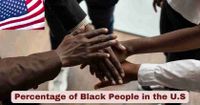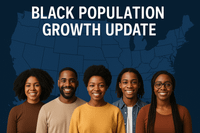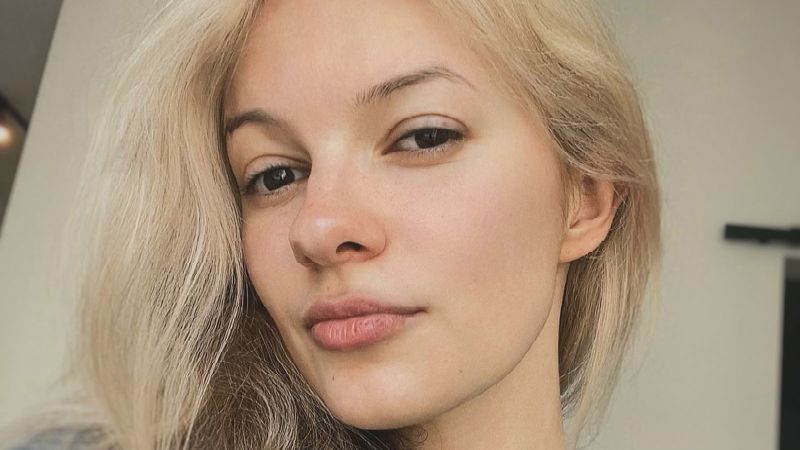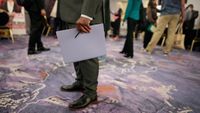Explore web search results related to this domain and discover relevant information.
Facts About the U.S. Black Population ... This fact sheet is based on Pew Research Center tabulations of microdata from the Census Bureau’s 2023 American Community Survey (ACS), provided through IPUMS from the University of Minnesota. · All displayed numbers are rounded. Shares and percent changes are calculated using ...
Facts About the U.S. Black Population ... This fact sheet is based on Pew Research Center tabulations of microdata from the Census Bureau’s 2023 American Community Survey (ACS), provided through IPUMS from the University of Minnesota. · All displayed numbers are rounded. Shares and percent changes are calculated using unrounded numbers.The detailed tables which have been made available display unrounded tabulations using IPUMS data. This fact sheet relies on people self-identifying their race and ethnicity in the Census Bureau’s 2023 ACS to describe the nation’s Black population. The racial and ethnic categories used in census data have changed over time, including question wording, formatting and instructions.Note about data on immigrants: A recent publication by the Census Bureau shows that immigrants are underrepresented in official population estimates used for the 2023 ACS. According to these recent population estimates, the U.S. population was larger than shown by the 2023 ACS by about 2 million people, or roughly 0.6%. Almost all of the additional people were immigrants who make up about 4% of the overall immigrant population shown in the 2023 ACS. In this fact sheet, we report data on the Black population – which includes data on immigrants – using the 2023 ACS.The terms multiracial, non-Hispanic Black and multiracial Black are used interchangeably throughout this fact sheet to refer to people who self-identify with two or more races and do not identify as Hispanic or Latino.

According to the bureau’s new estimates, the U.S. population was larger than indicated by the 2023 ACS by about 2 million people, or roughly 0.6%. Almost all of the additional people were immigrants. In this blog post, we report data on the Black population – which includes data on immigrants ...
The analysis identifies the nation’s Black population through self-reports of racial and ethnic identity on the 2023 ACS. The Black population includes single-race non-Hispanic Black people, multiracial non-Hispanic Black people and Black Hispanics. All displayed numbers are rounded. Shares and percent changes are calculated using unrounded numbers.Analyses of spouses’ race and ethnicity can only be done for spouses residing in the same household; that is, the spouse does not have a separate official residence, is not stationed away from home with the military, is not institutionalized, etc. For married Black adults, 91% reside with their spouse. Note about total population estimates: A recent publication by the Census Bureau shows that immigrants are underrepresented in official population estimates used for the 2023 ACS.According to the bureau’s new estimates, the U.S. population was larger than indicated by the 2023 ACS by about 2 million people, or roughly 0.6%. Almost all of the additional people were immigrants. In this blog post, we report data on the Black population – which includes data on immigrants – using the 2023 ACS.This includes those who say their race is only Black and that they are not Hispanic; those who say Black is one of two or more races in their identity and they are not Hispanic; and those who say they are either Black alone or in combination with other races and Hispanic or Latino. The terms Black population and Black people are used interchangeably.


This informal celebration of ‘Black history’ became formally recognised by the US Government in 1976, when President Gerald Ford urged all American people to, ‘seize the opportunity to honour the too-often neglected accomplishments of black Americans in every area of endeavour throughout ...
This informal celebration of ‘Black history’ became formally recognised by the US Government in 1976, when President Gerald Ford urged all American people to, ‘seize the opportunity to honour the too-often neglected accomplishments of black Americans in every area of endeavour throughout our history.’Friend agree that it is important to debate such subjects as Black History Month, so that we have an even greater understanding of history? Lucy Powell MP (Lab) (Co-op): I thank my hon. Friend for using an opportunity at Prime Minister’s questions yesterday and on other occasions to ask for a debate about Black History Month.The Black British History website, operated by the School of Advanced Study, University of London, provides a selection of useful resources.There will be a general debate on Black History Month on Thursday 24 October 2024. The debate will take place in the House of Commons Chamber.
The Dollar to Naira exchange rate in the black market continues to highlight Nigeria’s forex liquidity challenges as many Nigerians turn to the parallel
Black Market Exchange Rate For US Dollar to Naira Today, Tuesday, September 9th 2025Black Market Exchange Rate For US Dollar to Naira Today, Monday, September 8th 2025Black Market Exchange Rate For US Dollar to Naira Today, Friday, September 5th 2025The Dollar to Naira exchange rate in the black market continues to highlight Nigeria’s forex liquidity challenges as many Nigerians turn to the parallel market to access foreign exchange.

Through the creation of resources and initiatives, we support a network of African American Chambers of Commerce and business organizations in their work of developing and growing Black enterprises. ... USBC Media offers a diverse array of captivating and thought-provoking content, spanning ...
Through the creation of resources and initiatives, we support a network of African American Chambers of Commerce and business organizations in their work of developing and growing Black enterprises. ... USBC Media offers a diverse array of captivating and thought-provoking content, spanning various media formats.Developed by the U.S. Black Chambers, Inc. and presented by American Express, ByBlack.us Platform is an extensive directory database and the first national certification exclusively for Black-owned businesses. ByBlack is designed to provide Black entrepreneurs a way to reach new customers and get access to business resources.In an effort to provide Congress and corporate decision makers with a blueprint to supporting Black-owned businesses, we’ve published our annual BLACKprint– a set of principles that lays out a clear vision for policymakers and decision makers to move the needle on policies that strengthen the Black business community. Learn More · USBC Economic Development Corporation designs, develops and delivers financial education and business improvement programs to small businesses to stimulate revenue, sustainability, and job growth that spurs economic development.Join us to access our network of government and corporate relationships, free financial education, entrepreneurial training, and technical assistance, and promote your business in an array of programs provided by our corporate partners and presenting sponsors. Let us advocate and fight for you and our community to move the Black economic agenda forward.


Percentage of Black People in the US 2025 The Black or African American population continues to represent a significant and growing demographic in the United States, with recent government data showing substantial changes in both population size and percentage representation.…
As we examine the most current statistics for 2025, the percentage of Black people in America reflects not only natural population growth but also increased diversity in racial identification patterns across the nation.The latest Census Bureau data provides comprehensive insights into how the Black American population has evolved, including both those who identify as Black alone and those who identify as Black in combination with other races, revealing a more complex picture of racial identity in modern America.The growth of the Black population over time is particularly significant. Since the year 2000, the total Black population has grown by 33%, driven by both natural growth and increased immigration. The Black multiracial segment has experienced an especially sharp rise, increasing by an extraordinary 88.7% since 2010.In contrast, the Black alone population—those who identify solely as Black—has grown at a slower pace of 5.6% over the same period. These trends highlight the evolving nature of racial self-identification in America, with more individuals embracing multiracial backgrounds.

Black Population in the U.S. Reaches 51.6 Million in 2024Non-Hispanic Black Alone population now at 43.1 million, but growth is strongest among multiracial and Hispanic-identifying Black populations The U.S. Census Bureau’s latest population estimates (June 2025 release) show that the total ...
Black COVID-19 Tracker · Health status & Life Expectancy · Obesity · Abortion · HIV & Aids · What We Do · What We Do · Get Your Local Reports · Custom Data Analysis · Infographic · ABOUT/CONTACT US · Akiim DeShay · RESOURCES · Books · Documentaries ·Black COVID-19 Tracker · Health status & Life Expectancy · Obesity · Abortion · HIV & Aids · What We Do · What We Do · Get Your Local Reports · Custom Data Analysis · Infographic · ABOUT/CONTACT US · RESOURCES · Books · Documentaries · Terms of Service ·Black Population in the U.S. Reaches 51.6 Million in 2024Non-Hispanic Black Alone population now at 43.1 million, but growth is strongest among multiracial and Hispanic-identifying Black populations The U.S. Census Bureau’s latest population estimates (June 2025 release) show that the total Black population in the United States has reached 51,629,710, or 15.2% of the total […]The U.S. Census Bureau’s latest population estimates (June 2025 release) show that the total Black population in the United States has reached 51,629,710, or 15.2% of the total U.S. population (340.1 million).

The acceptable terms in America for identifying black people have evolved over generations, from colored to Negro to black and African-American. Also commonly used is “people of color,” an umbrella term used to include many ethnic minorities.
In the aftermath of the George Floyd killing, which has unleashed a national conversation on questions of race and racism, many say the country is long overdue to standardize the use of the uppercase B in black, which has been commonly used at black media outlets for a long time.With the rise of the Black Power movement in the mid-1960s, the word black, once seen as an insult for many African-Americans, started winning embrace. In just a few years, it became the predominant descriptor of black people as Negro became obsolete. Mr. Jackson’s campaign brought African-American into popular use in the late 1980s, and it is now often used interchangeably with black.Now Dr. Fleming, a professor at the State University of New York at Stony Brook and the author of “How to be Less Stupid About Race,” is writing a book for young people about fighting racism. She has decided to use Black.“Black is a color,” said the Rev. Jesse L. Jackson, the longtime civil rights leader who popularized the term “African-American” in an effort to highlight the cultural heritage of those with ancestral ties to Africa. “We built the country through the African slave trade. African-American acknowledges that. Any term that emphasizes the color and not the heritage separates us from our heritage.”
Gbenga Ajilore, chief economist ... sees Black unemployment as a “canary in the coal mine.” He added, “If it’s steadily starting to go up, that portends that the economy might be heading toward a downturn." The country’s broader unemployment rate had been hovering between 4% and 4.2% since May 2024, only to crack out of that narrow band and hit 4.3% in August’s bruising jobs report, which showed the US economy added ...
Gbenga Ajilore, chief economist at the left-leaning Center on Budget and Policy Priorities, similarly sees Black unemployment as a “canary in the coal mine.” He added, “If it’s steadily starting to go up, that portends that the economy might be heading toward a downturn." The country’s broader unemployment rate had been hovering between 4% and 4.2% since May 2024, only to crack out of that narrow band and hit 4.3% in August’s bruising jobs report, which showed the US economy added just 22,000 jobs that month.Unemployment for Black Americans is at its worst level since the pandemic, with some economists seeing the latest results as a sign of worse things to come for the US economy.The unemployment rate for Black Americans hit 7.5% in August. Federal workforce reductions and tariff-fueled economic uncertainty may be contributing.US Europe Asia Cryptocurrencies Rates Commodities Currencies

USA All Gallup Headlines Black American Experience Minorities and Discrimination Race Relations Social and Policy Issues
Nearly two-thirds of Americans say racism against Black people is widespread, even as slightly more than that say they've seen civil rights gains.Each sample of national adults includes a minimum quota of 80% cellphone respondents and 20% landline respondents, with additional minimum quotas by time zone within region. Landline and cellular telephone numbers are selected using random-digit-dial methods.These findings are based on a June 2-26 Gallup survey that included oversamples of Black and Hispanic adults to allow for more precise estimates among those subgroups. The overall sample was weighted so all racial/ethnic groups are represented in their proper proportions of the U.S.When Gallup first asked this question in 2008, 56% of U.S. adults thought racism was widespread. However, by the following year, at the start of Barack Obama’s presidency, it had dipped to 51%. The next reading, 60% in 2015, came after several high-profile killings of Black people by White police officers.
A repeat criminal offender is facing a federal charge in the fatal stabbing of a Ukrainian refugee last month on a train in Charlotte, North Carolina, in the latest escalation of a case fueling a White House crusade against purported violent crime in Democratic-led cities.
CNN’s Stephen Watts, Holly Yan, Sara Smart, Dianne Gallagher and Mia Blackman contributed to this report.Brown also has been charged in North Carolina with first-degree murder. He used a pocketknife during the crime, which was found near a train platform, an affidavit in support of the criminal complaint filed against him states.She had received a degree in art and restoration in Kyiv and hoped to become a veterinary assistant. She was living in a bomb shelter before coming to the US, where she had recently moved in with her partner.The incident remains under investigation and Brown could face additional charges, Russ Ferguson, US Attorney for the Western District of North Carolina, said during a news conference Tuesday.

Now, the distinction between "black" and "African American" has become a prominent conversation on social media. Many people often default to "African American" out of a desire for either political correctness or politeness. The two terms are often used interchangeably, but that isn't always ...
Now, the distinction between "black" and "African American" has become a prominent conversation on social media. Many people often default to "African American" out of a desire for either political correctness or politeness. The two terms are often used interchangeably, but that isn't always accurate, and it's important to understand the nuance when discussing race both in America and on a global scale.𝗜𝘀 𝗶𝘁 𝗿𝘂𝗱𝗲 𝘁𝗼 𝗰𝗮𝗹𝗹 𝘂𝘀 𝗕𝗹𝗮𝗰𝗸? Let's talk semantics. Whether it was a teacher, coach, acquaintance, or stranger, I’ve always noticed a slight hesitation with this, which shows me they're unsure of which term is appropriate. Black or African-American?Over time, immigration to the United States increased, and people who identify as black in America were also likely to be first and second-generation immigrants without a direct connection to the history of slavery in this country.LaBeach's experience is just one example of the complexities of black identities, especially in the United States. Some people originally from other countries who live in the U.S. accept African American because of its cultural and historical roots in the black experience that is specific to this country.

An indentured servant (who could be White or Black) would work for several years (usually four to seven) without wages. The status of indentured servants in early Virginia and Maryland was similar to slavery. Servants could be bought, sold, or leased, and they could be physically beaten for ...
An indentured servant (who could be White or Black) would work for several years (usually four to seven) without wages. The status of indentured servants in early Virginia and Maryland was similar to slavery. Servants could be bought, sold, or leased, and they could be physically beaten for disobedience or attempting to running away.First established in South Carolina in 1704, groups of armed White men—slave patrols—were formed to monitor enslaved Black people. Their function was to police slaves, especially fugitives. Slave owners feared that slaves might organize revolts or slave rebellions, so state militias were formed to provide a military command structure and discipline within the slave patrols. These patrols were used to detect, encounter, and crush any organized slave meetings which might lead to revolts or rebellions.However, actually these privileges distanced free Black men from enslaved Blacks and encouraged them to identify with Whites. Slavery had been tacitly enshrined in the US Constitution through provisions such as Article I, Section 2, Clause 3, commonly known as the 3/5 compromise.Fugitive slave laws (derived from the Fugitive Slave Clause of the Constitution—Article IV, Section 2, Clause 3) were passed by Congress in both 1793 and 1850, guaranteeing the right of a slaveholder to recover an escaped slave anywhere within the US. Slave owners, who viewed enslaved people as property, ensured that it became a federal crime to aid or assist those who had fled slavery or to interfere with their capture. By that time, slavery, which almost exclusively targeted Black people, had become the most critical and contentious political issue in the Antebellum United States, repeatedly sparking crises and conflicts.Prior to the Civil War, eight serving presidents had owned slaves, a practice that was legally protected under the US Constitution. By 1860, the number of enslaved Black people in the US had grown to between 3.5 and 4.4 million, largely as a result of the Atlantic slave trade.

It’s Black History Month, and I wanted to dive into a controversial yet important conversation—Who is Black? And why do some people, particularly in Africa, ...
AboutPressCopyrightContact usCreatorsAdvertiseDevelopersTermsPrivacyPolicy & SafetyHow YouTube worksTest new featuresNFL Sunday Ticket


Unemployment for Black Americans has led some Black-owned small-business owners to worry about an end-of-year sales slump. In Atlanta, Charmaine Gibbs-West, the owner of beauty brand Essence Tree, said she will have to let go of one contracted worker and won’t know whether she can bring back the contractor until the fourth quarter, which is usually ...
Unemployment for Black Americans has led some Black-owned small-business owners to worry about an end-of-year sales slump. In Atlanta, Charmaine Gibbs-West, the owner of beauty brand Essence Tree, said she will have to let go of one contracted worker and won’t know whether she can bring back the contractor until the fourth quarter, which is usually the busiest time for her company.Black Americans make up about 13% of the US workforce.A drop in Black Americans in the workforce can have a crippling effect on Black communities and on the US economy, which some economists say is already in a slowdown.“The most vulnerable people tend to get laid off first, and unfortunately, that tends to be Black Americans, and that’s something that is very disturbing in and of itself,” said Diane Swonk, chief economist at accounting firm KPMG US.

Black excellence shone brightly at the 2025 US Open in Queens, New York, which concluded on Sunday, September 7. The presence of accomplished women such as
The presence of accomplished women such as 45-year-old Venus Williams, a seven-time Grand Slam champion, and Haitian-Japanese tennis sensation Naomi Osaka, a four-time Grand Slam winner, elevated the tournament. Collectively, these Black women—who have won four of the last nine US Open titles—continued to make their mark on the sport.This year’s US Open was also a jubilant celebration of the legendary Althea Gibson, the first Black player to compete in the US Nationals in 1953. Gibson went on to win the tournament in 1957 and 1958, cementing her place in history.Gibson’s legacy was further explored in a panel discussion, “Althea’s Legacy: Celebrating a New Era in Black Tennis,” featuring actor and former player Boris Kodjoe, 2017 US Open champion Sloane Stephens, former player and executive Leslie Allen, and tennis coach Kamau Murray, with ESPN personality Monica McNutt as moderator.Though no Black professional player captured the title, the 2025 US Open was a vibrant celebration of Black excellence on and off the court.

The United States will evaluate demands made by Russia after Moscow had agreed "in principle" to a U.S.-brokered ceasefire with Ukraine in the Black Sea to allow safe navigation, U.S. Secretary of State Marco Rubio said on Wednesday.
The U.S. announced separate Black Sea agreements with Ukraine and Russia on Tuesday - following talks in Saudi Arabia - to ensure safe navigation, stop attacks, and prevent the use of commercial vessels for military purposes.KINGSTON, March 26 (Reuters) - The United States will evaluate demands made by Russia after Moscow had agreed "in principle" to a U.S.-brokered ceasefire with Ukraine in the Black Sea to allow safe navigation, U.S.The conditions listed in a statement by the Kremlin on Tuesday - including the lifting of restrictions and sanctions on a major agricultural bank, exporters of food and fertilizer and on Russian vessels - largely mirror demands made by Moscow two years ago during talks to extend a Black Sea deal first agreed in July 2022.The 2022 deal was brokered by the United Nations and Turkey to allow the safe Black Sea export of Ukrainian grain. Under an accompanying three-year pact, the U.N.

Black-Owned Businesses in the US.
Explore the 2025 update on Black population across U.S. counties with county-level data, trends, and demographic insights.We use cookies to ensure that we give you the best experience on our website.If you continue to use this site we will assume that you are happy with it.OkAs of 2025, the Black population in the United States has reached a record high, more than 51 million people, according to BlackDemographics. Yet the real story isn’t just in the numbers; it’s in the map.
Following Nat Turner's rebellion ... to limit Black people's access to education intensified. But enslaved people found ways to learn. From May 2 to May 5, 1963, thousands of children left their schools in Birmingham, Alabama, to march for civil rights. Police officers responded by using water cannons ...
Following Nat Turner's rebellion of 1831, legislation to limit Black people's access to education intensified. But enslaved people found ways to learn. From May 2 to May 5, 1963, thousands of children left their schools in Birmingham, Alabama, to march for civil rights. Police officers responded by using water cannons and dogs to attack and then arrest the children.0:04m watchDuring the civil rights movement of the 1950s and ’60s, Black Americans used non-violence to advance the struggle for social justice and equal rights under the law.His use of Black bodies as medical test subjects falls into a history that includes the Tuskegee syphilis experiment and Henrietta Lacks.Black history is the story of African Americans in the United States and elsewhere. Learn about Black History Month, ...

To reestablish “cultural integrity” in the late 1980s, Jesse Jackson proposed African American, which—unlike some “baseless” color label—proclaims kinship with a historical land base. In the 21st century the terms Black and African American both were widely used.
Actor Djimon Hounsou hopes Black history run becomes pilgrimage for African Americans • Sep. 9, 2025, 1:29 AM ET (USA Today) ...(Show more)African Americans constitute one of the largest ethnic groups in the United States. African Americans are mainly of African ancestry, but many have non-Black ancestors as well. Learn more about African Americans, including their history, culture, and contributions.Inside the DuSable Black History Museum and Education Center (formerly the DuSable Museum of African American History)A discussion of the DuSable Museum of African American History (now the DuSable Black History Museum and Education Center) in Chicago, from the documentary Riches, Rivals, & Radicals: 100 Years of Museums in America.(more)See all videos for this articleAt the turn of the 21st century, more than half the country’s more than 36,000,000 African Americans lived in the South; 10 Southern states had Black populations exceeding 1,000,000. African Americans were also concentrated in the largest cities, with more than 2,000,000 living in New York City and more than 1,000,000 in Chicago.










